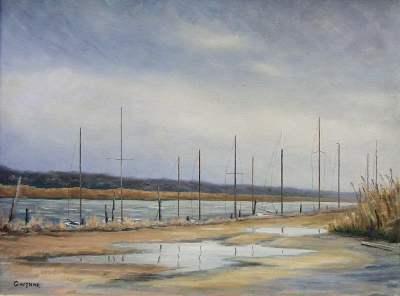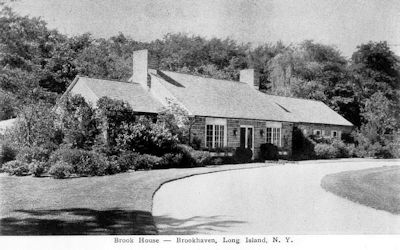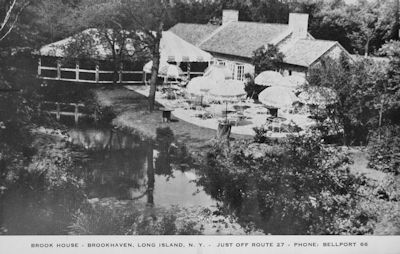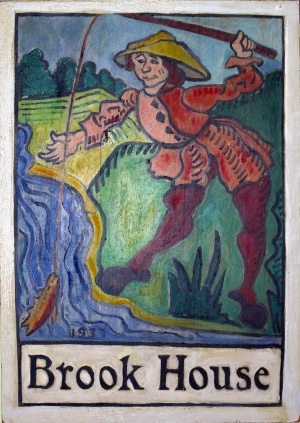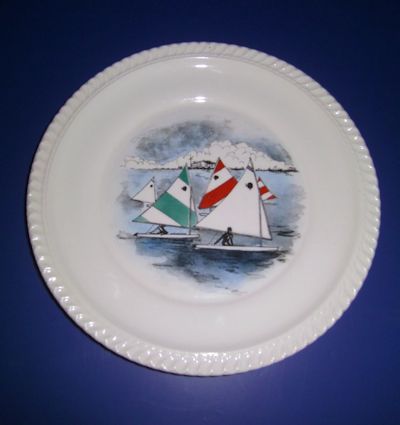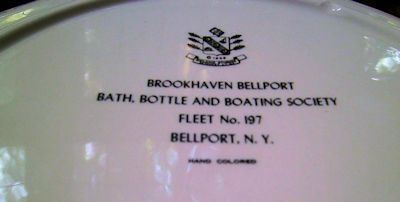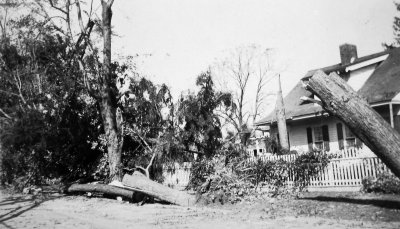Patchogue Advance, 31 July 1936, p. 9
In some cases, links are provided to individuals in the Hamlet People database. Because of ambiguities in some of the names, I am not always certain that the link is to the correct person.
Razing of Old Carman Homestead Brings Notes of Ancient Ways
When a house has stood for several generations is torn down, it is like the turning of a page in the book of time. That which was an actuality becomes a memory. It recedes into the past—quickly for some people, slowly for others, depending upon the vividness of its image, in their minds.
Almost a century and a half ago a house was built in South Haven, overlooking a mill pond in the Connecticut river. Nearby there was a saw mill, a grist mill and a fulling mill (where cloth was made) and all of them were kept busy. The house was owned and occupied by Samuel Carman, who is thought to have come from Hempstead about 1780. Whether he built the house or whether it was there when he came, cannot be determined, but apparently the original structure was added to at different times. The western end of the house was three stories high, but the eastern wing was only two, and gives evidence of being of a later date. An old mill stone served as a doorstep to the old part.
Samuel Carman’s wife was Theodosia Homan![]() note and their marriage was recorded in the Presbyterian church at Setauket, as she may have been a native of that village. (The Presbyterian parish of South Haven dates back to 1740 but the church, which is opposite the Carman house, was not built until 1827 and dedicated on New Year’s day, 1828.)
note and their marriage was recorded in the Presbyterian church at Setauket, as she may have been a native of that village. (The Presbyterian parish of South Haven dates back to 1740 but the church, which is opposite the Carman house, was not built until 1827 and dedicated on New Year’s day, 1828.)

Mills and Mails There
The Carman house was a busy place, for as well as being near the mills (which Samuel Carman also owned), it was a mail distributing center. Moreover, the pond and river abounded in fish and was a Mecca for anglers. Gentlemen from New York came out to enjoy the sport and were undoubtedly put up at “the most estimable hostelry,” as the place was once called. Martin and John Van Buren frequently stopped there and a receipt for lodging, signed by Daniel Webster, is said to be still in existence.
Another thing still in existence which antedates Webster’s time and sheds considerable light on this community as it was 140-odd years ago, is a day-book found in the attic of the Carman house a few weeks ago when Charles E. Robinson, the present owner, was having the larger part of the house demolished.
This book, about 13 inches long by 8 inches wide, is made by hand of heavy, imported rag paper which bears the watermark of the crown and the letters G. R. (Georgius Rex, or King George). Several thicknesses of paper, sewn together, are used for the covers and the whole is fastened together with coarse thread. The outside is yellowed and soiled, but one can easily distinguish the words, “Book No. 4 CARMAN & REED, Septr 20th 1789.”
Prices in Pounds, Shillings
Within there are entries of articles sold and the names of the buyers. The names indicate that the transactions presumably took place at the hostelry, or one of the mills, as they are indigenous to this locality and represent such villages as Mastic, Yaphank, Center and East Moriches, Patchogue and East Patchogue, Manorville, Blue Point, Coram and Middle Island. The prices are in pounds, shillings and pence, which was Yorkshire currency, or half the value of the present English money. This was legal tender in this country before the Revolution and continued in use, especially in rural communities, until about 1820.
The hand-writing, which is in ink now turned brown, shows two distinct types of penmanship. One is full and fine, while the other is cramped, and apparently written byan older man as he used more antiquated forms of spelling and chifography. No doubt both gentlemen would they have known that their account book, which was a familiar and everyday article to them, would one day be looked upon as a curio and relic of the past. One of them, evidently trying his quill pen, wrote inside the cover of the book, “Money makes the mare go.”
Each page has the word, “Brookhaven” and the date, written across the top. Evidently they used the name of the town, for the name South Haven had been adopted by public vote in 1757, meaning “South Brookhaven” (Town). Brookhaven village was known as Fireplace until 1871. The Town map of 1797 designates the mills at South Haven as “Fire Place Mills,” but neither these village names appears in this book. According to Osborn Shaw, local historian, it was customary to mark deeds and legal papers with the town name, rather than that of the village, until about 1850.
The most frequent items sold were molasses, rum, papers of tobacco, powder and shot. A typical page follows:
Stephen Overton Esq. Son
1 pr Shoe Buckles …. 0-2-6
1 yd black Ribbon …. 0-0-6
Joseph Raynor Junr.
Credit by Clover seed …. 0-6-2
David Hallack Dr.
To Balance of Tallow …. 0-1-0
Morris Homan, Dr.
To 1¼ yds. blue sarge …. 0-10-0
To ½ yd. Baize …. 0-3-0
John C. Benz Dr.
To ¼ lb. Snuff …. 0-2-0
Nathan R. Burto Cr. ….
12½ lbs. Flax …. 0-7-3
Dr. to ½ lb. Tobacco …. 0-0-9
Boats Brought Freight
Other entries which attract one’s attention and stir the imagination are as follows:
“20th Octr. 1798. Barnabas Rider, Dr. to 1 lb. wool. Lent him bag.” “16th Nov. 1789. Sloop Dolphin. To 5 qts. Rum.” This sloop apparently sailed up the winding river, at least part way, and sent its rowboat the rest of the way. It is known that the gentlemen who later formed the Suffolk club (now out of existence) and bought 75 acres of land from Samuel Carman, including the pond and grist-mill, owned a sloop which moored at Black Grass dock, part way up the river. There were no bridges at that time. The ford (where the remains of an old wooden bridge can still be seen) was called “the goin’over.” “Zach’s Landing,” named after Zachariah Hawkins of Revolutionary fame, was used by the Long Island railroad company as the foundation of the eastern abutment of the railroad crossing when the line was put through.
“29th Oct. Mordecai Homan, Dr. to ½ gall. Molasses.” He was the father of Mordacai Homan of Yaphank who became town clerk.
“24th Nov. Wm. Smith, Judge, Dr. to 1 lb. pepper, 1 lb allspice.” This was the Smith who was in exile from his property and hiding from the British from 1776 to 1783. He was the father of General John Smith, United States senator. He in turn, was the father of William Smith who was called colloquially, “Billy Pint” (William on the Point). “Billy Pint” was father of Egbert Tangier Smith and grandfather of the present Miss Eugenia Smith of the manor of St. George.
Another customer was John Rose, “Dr. to ¼ lb powder, 1 lb shot.” He became State senator and his trips from here to Albany on horseback used to take two weeks each.
William Floyd of Mastic, signer of the Declaration of Independence, is entered as follows: “Dec. 15th 1789, Wm Floyd To his Order in favor of Isaac Hannible …. 16 shilling.” Hannible is known to have been a negro and was probably a slave owned by the Floyd family.
Mary Jayne Bought Snuff
One of the few women customers was “Mary Jayne, Dr. to 2 oz. Snuff …. sixpence.” Another was Mary Coree, Dr. to 1 pr black Mitts …. 3 shillings, sixpence.” Nancy Brown bought “fustian,” a linen and and cotton material, and also “one stick of mohare”—a yard, no doubt.
On May 2nd, 1790, Nathaniel Brewster purchased one spelling book. One wonders if he were the school teacher, or a pupil.
Hugh Smith was charged 9 shillings for “Dressing 2 dear Skins.” “To sawing for Richard Robinson, 2 logs for lath, 390 feet of inch boards,” is another entry. Also, “1797, John Post, Dr. To sawing 11870 feet of inch boards. Cr. to 1 bushel of wheat.” Evidently the services performed at the mill were many and varied.
In the back of the book there are memoranda of articles which evidently were left at the establishment to be sold, as, for instance, “Dec 17th, 1792, Left with Mr. Carman 2 pare of men’s Shoes at 10/. 4 pare of women’s at 7/6 …. Mathew Howell.” Howell was evidently a cordwainer, or shoemaker, who distributed his goods in that way.
There is also a list of garments including such items as, “1 green Coat …. 2 pare of Velvet Breeches …. 2 pare of Nan Keen (nankeen, a brownish, cotton cloth) Breeches …. 1 Nan Keen Vest.”
The name Samuel Carman appears frequently in the day-book as, for instance, “Dr. to a Balance Due on Goods bought in New York for him Nov 6th, 1789 to Jan 1st, 1790 …. 4 pounds, seven shillings, fourpence.” Also, “Samuel Carman, Dr. to Sundry Freight …. 1 barrell & Saddles of Venison …. To weighing Saddles of Venison …. To Bbl Rum. 1 Bushel Flaxseed …. To carting Bbl Rum & Flaxseed.”
Samuel Carman had a son named Samuel also and he, in turn, was proprietor of the tavern. He is said to have had 12 children, and one of his sons, Henry, inherited the homestead. Another son, Robert, owned the property recently known as Hunters’ inn. The Connecticut river became known as Carman’s river and is still called by that name.
The mill pond and the gray-shingled grist mill which is part of the late Anson Hard’s estate (formerly the Suffolk club) lies just back of the site of the Carman house and is perhaps th only part which is undisturbed by the march of time. The water is deep and cold by the mill, but shallow and clear around the edges of the peaceful pond. Though the mill has long since ben stilled, it remains a picturesque reminder of other times, other customs.

